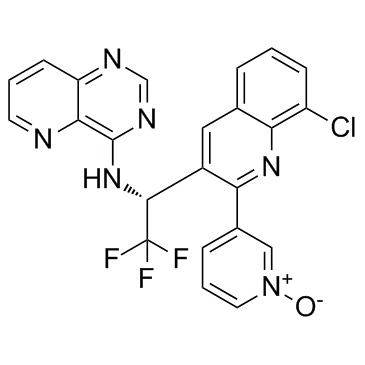| Cas No.: | 1362850-20-1 |
| Chemical Name: | Seletalisib |
| Synonyms: | Seletalisib;UCB5857;(R)-3-(8-chloro-3-(2,2,2-trifluoro-1-(pyrido[3,2-d]pyrimidin-4-ylamino)ethyl)quinolin-2-yl)pyridine 1-oxide;64CW205BDD;GTPL9800;BCP29404;UCB 5857;DB12706;A16797;Q27263741;3-{8-chloro-3-[(1R)-2,2,2-trifluoro-1-({pyrido[3,2-d]pyrimidin-4-yl}amino)ethyl]quinolin-2-yl}pyridin-1-ium-1-olate |
| SMILES: | ClC1=CC=CC2=C1N=C(C1=CC=C[N+](=C1)[O-])C(=C2)[C@H](C(F)(F)F)NC1C2C(=CC=CN=2)N=CN=1 |
| Formula: | C23H14ClF3N6O |
| M.Wt: | 482.845073223114 |
| Purity: | >98% |
| Sotrage: | 2 years -20°C Powder, 2 weeks 4°C in DMSO, 6 months -80°C in DMSO |
| Description: | Seletalisib is a potent, ATP-competitive and highly selective PI3Kδ inhibitor able to block AKT phosphorylation following activation of the BCR in a B-cell line. Seletalisib inhibits N-formyl peptides (fMLP)-stimulated but not phorbol myristate acetate (PMA)-stimulated superoxide release from human neutrophils consistent with a PI3Kδ-specific activity. No indications of cytotoxicity are observed in PBMCs or other cell types treated with seletalisib. seletalisib blocks human T-cell production of several cytokines from activated T-cells. Seletalisib inhibits T-cell differentiation to Th1, Th2, and Th17 subtypes. Additionally, seletalisib inhibits B-cell proliferation and cytokine release. In human whole blood assays, seletalisib inhibits CD69 expression upon B-cell activation and anti-IgE-mediated basophil degranulation.Seletalisib significantly inhibits IL-2 release following TCR stimulation in the rat. The inhibition is observed at all tested doses of seletalisib with almost complete inhibition reached at dose levels ≥1 mg/kg. Seletalisib has potent in vivo effects with an estimated IC50 value of <10 nM. |

 DC Chemicals' products qualify for U.S. tariff exemptions. We guarantee no price increases due to customs duties and maintain stable supply, continuing to deliver reliable research solutions to our American clients.
DC Chemicals' products qualify for U.S. tariff exemptions. We guarantee no price increases due to customs duties and maintain stable supply, continuing to deliver reliable research solutions to our American clients.





















